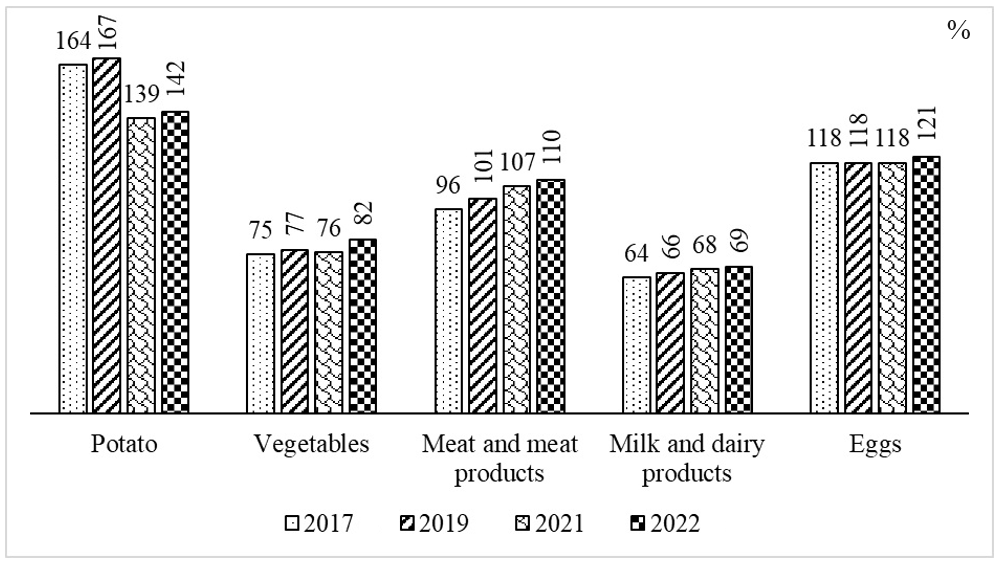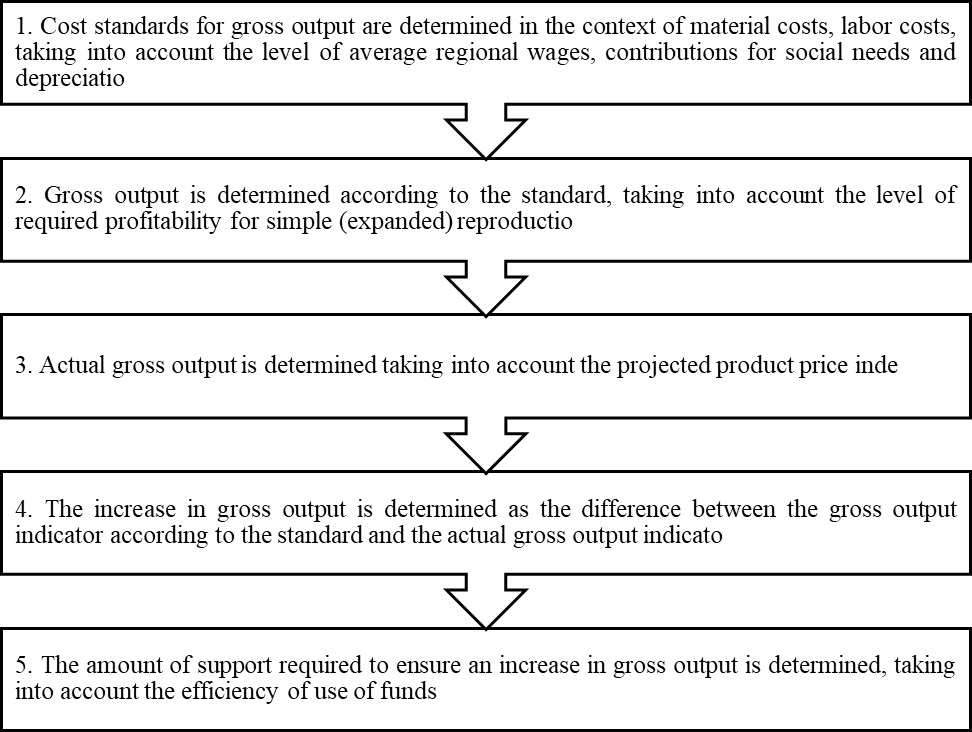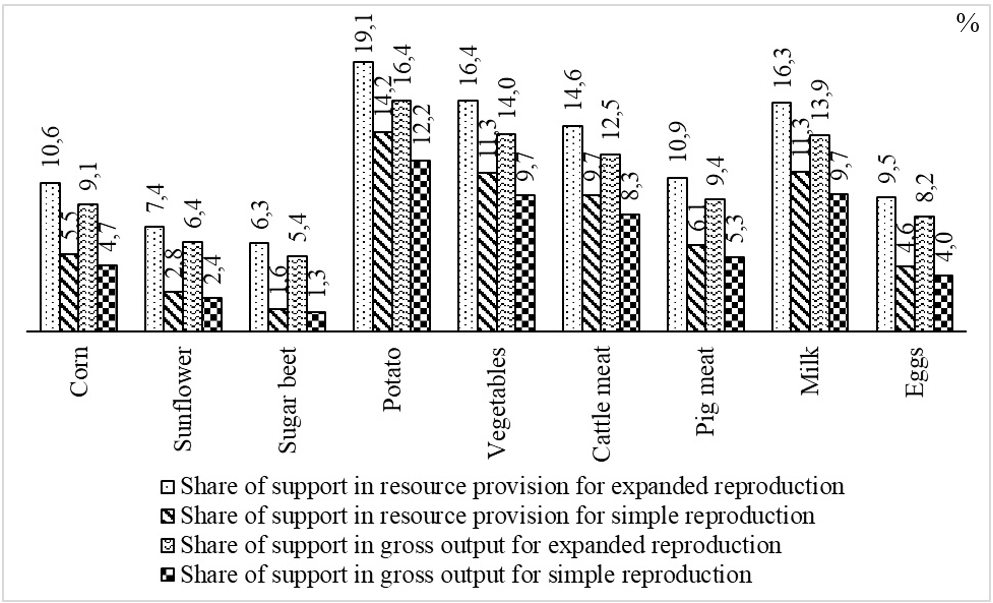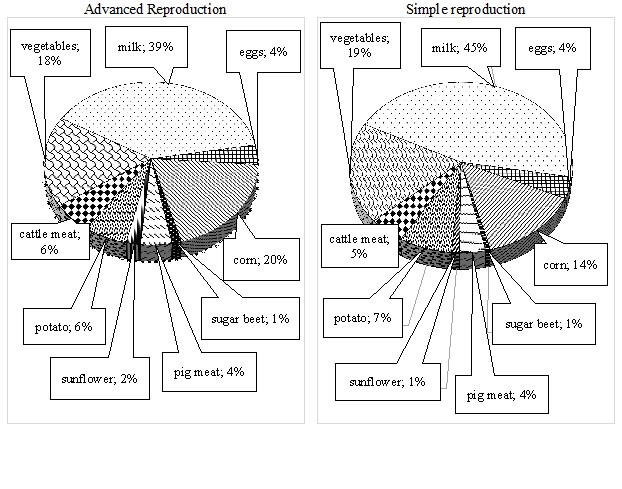Стратегическое планирование бюджетного обеспечения физической доступности продукции
Стратегическое планирование бюджетного обеспечения физической доступности продукции
Аннотация
Рассматривается проблема повышения целенаправленности средств господдержки товаропроизводителей на решение стратегических задач по обеспечению физической доступности продукции на уровне норм рационального потребления. Проведенная аналитика предлагаемых в науке методов планирования господдержки показала, что их имитационных возможностей недостаточно для обоснования размера субсидирования развития сельского хозяйства и обеспечения продовольственной безопасности как комплексной проблемы. Авторами разработана методика, позволяющая определить уровень финансового обеспечения производства продукции в объеме физической доступности и размер субсидий для создания условий воспроизводства ресурсов. Алгоритм расчета заключается в определении необходимого объёма валовой продукции, обеспечивающего степень покрытия затрат на ее производство с учетом субсидий на заданном уровне рентабельности. Методика является социально-ориентированной и учитывает взаимосвязь доходов производителей и заработной платы работников сельского хозяйства. Использование методики в практике стратегического планирования обеспечит условия формирования таких объемов и структуры производства основных видов продукции, которые оптимальным образом увязаны с рациональными нормами потребления.
1. Introduction
Today, in the field of food security, fundamentally new strategic tasks have been set to ensure the physical and economic availability of products for every citizen of the country at the level of rational consumption standards and above. Physical is primary in relation to the economic accessibility of products – without the availability of products, it is impossible to ensure their consumption. At the same time, there is reason to believe that economic accessibility stimulates physical accessibility - demand creates supply. It is in this context that more and more scientists and specialists
, , are moving towards the idea that increasing the purchasing power of the population and increasing the effective demand for products should enter the arena of strategizing the agricultural sector. At the same time, under the influence of growing demand for food, imports of products are increasing at a faster pace, rather than production within the country. This phenomenon has been proven by a number of leading experts , in the field of strategic planning for the development of the agro-industrial complex. According to a group of scientists , , , , and the authors of the article, in the current conditions, when food supply chains are losing their stability, the feasibility of creating physical accessibility at the expense of domestic producers increases, especially since Russia has sufficient agricultural and resource potential to solve this problem.In the last decade, the country's agricultural policy has intensified significantly. The volume of budget allocations allocated to support agriculture has increased significantly, and the volume of credit resources issued by banks has increased
. Meanwhile, the level of production per capita for certain types of products, which characterizes physical accessibility, has not been formed and has a weak tendency towards self-sufficiency of rational consumption standards (Fig. 1).
Figure 1 - Dynamics of the ratio of the level of production per capita with rational standards for certain types of products in 2017-2022
2. Research methods and principles
Today, planning methodology has developed several fundamentally different approaches, which are offered by the All-Russian Research Institute of Economics and Standards – a branch of the Rostov Scientific Agrarian Center
, the All-Russian Research Institute of Agricultural Economics , the All-Russian Research Institute of Organization of Production, Labor and Management in Agriculture - a branch of the All-Russian Research Institute of Agricultural Economics . However, the results of the critical analysis indicate that there is no possibility of successfully applying these methodological approaches in the practice of strategic planning for agricultural development and ensuring food security as a complex problem. The main difficulty is that in the process of justifying the financial needs of agriculture, support funds are not linked to the “desired” level of physical availability of agricultural products.The methodology proposed by the authors is based on methods of calculation and normative planning. Product production volumes to create physical accessibility must be consistent with the norms of rational consumption. Determining the volume of necessary funds for production should occur through a balance sheet linkage with final indicators (production volumes, resources and profitability). The technique can be considered in the form of the following algorithm (Figure 2).

Figure 2 - Algorithm for calculating the level of financial support for agricultural production
According to the authors, to ensure simple reproduction, the required level of profitability is in the range not lower than the price index for material and technical resources, but also not lower than the weighted average rate on deposits, otherwise the point of doing business is lost. According to the Central Bank of the Russian Federation
, in January 2024 the size of this rate was 15.84%. For expanded reproduction, it is also important to ensure a certain annual increase in production. OECD countries, even with a high level of physical accessibility, predict 15% growth in the next decade . In Russia, we believe that annual growth of at least 5% is necessary. As a result, for those types of products where physical availability is at or above rational standards, it is recommended to use the profitability value for simple reproduction (15-16%), for those types where physical availability is below rational standards – the value for expanded reproduction (24-25%). As a result, to ensure profitability at the level of 15% (25%) it is necessary that the gross output exceeds the cost of its production by 1.15 (1.25) times.The methodology is socially oriented and takes into account the relationship between the income of producers and wages of workers, which in the calculations is increased to the average level for the region. The peculiarity of the methodology is also that it is based on the production and budgetary efficiency of the use of funds, which allows, at the pre-project stage, to determine and take into account indicators of production growth, efficiency, profit and profitability of production from support, as well as the payback and capacity of subsidies in agriculture. The financial component of production projects is calculated for each type of product per unit of sown area, head of animals and in general.
3. Main results
Calculations using the developed methodology show that in order to ensure conditions for the reproduction of labor and material and technical resources, even while maintaining the current level of material costs and depreciation, state support for agricultural production must be increased (Table 1).
Table 1 - Planned level of budget support for projects for the production of main types of agricultural products per unit of sown area
Products | Reproduction | Deviation of current from, % | |||
extended | simple | current | extended | simple | |
Grain, thousand rubles per 1 ha | 2.2 | 1.1 | 0.6 | -72.7 | -45.5 |
Sunflower, thousand rubles per 1 ha | 1.8 | 0.7 | 0.7 | -61.1 | 0.0 |
Sugar beets, thousand rubles per 1 ha | 6.4 | 1.6 | 3.8 | -40.6 | 137.5 |
Potatoes, thousand rubles per 1 ha | 44.5 | 32.9 | 6.3 | -85.8 | -80.9 |
Vegetables, thousand rubles per 1 ha | 107.1 | 73.8 | 19.5 | -81.8 | -73.6 |
Cattle meat, thousand rubles for 1 head. | 6.3 | 4.2 | 1.5 | -76.2 | -64.3 |
Pig meat, thousand rubles for 1 head. | 1.2 | 0.7 | 0.4 | -66.7 | -42.9 |
Milk, thousand rubles for 1 head. | 16.7 | 11.6 | 3.4 | -79.6 | -70.7 |
Eggs, rub./head | 119 | 57.7 | 53.6 | -55.0 | -7.1 |
Note: head of livestock
So, for grain per 1 hectare of sown area it should be 1.1 thousand rubles for simple reproduction, for extended reproduction – 2.2 thousand rubles, for vegetables – 73.8 and 107.1 thousand rubles. Accordingly, for cattle meat per head of animals – 4.2 thousand rubles for simple and 6.3 thousand rubles for expanded reproduction, for milk – 11.6 and 16.7 thousand rubles per head of animals, accordingly, the share of support in resource provision and in gross output is increasing. Thus, for simple reproduction, the share of support for grain production in resource provision will be 5.5%, in gross output – 4.7%, vegetables – 11.3% and 9.7%, respectively, cattle meat – 9.7% and 8, respectively 8.3%, milk – 11.3% and 9.7%, respectively (Figure 3).

Figure 3 - Share of support in resource provision and in gross production of main types of agricultural products
Today there is a slight increase in prices for resources, an increase in prices for agricultural products, an increase in depreciation and wages. Taking into account possible changes in these components, the total amount of state support for agriculture was calculated by type of product. To maintain and increase the achieved level of production, a certain increase in state support is required (Table 2).
Table 2 - Planned volume of state support for agricultural production and ensuring the physical availability of products in 2024-2028
Products | Simple / Advanced Reproduction | |||||||||
2024 | 2025 | 2026 | 2027 | 2028 | ||||||
Corn, billion rubles | 80 | 186 | 83 | 192 | 86 | 199 | 89 | 206 | 92 | 213 |
Sunflower, billion rubles | 6 | 21 | 7 | 21 | 7 | 22 | 7 | 23 | 7 | 24 |
Sugar beet, billion rubles | 4 | 13 | 4 | 14 | 4 | 14 | 4 | 15 | 4 | 15 |
Potato, billion rubles | 39 | 54 | 40 | 56 | 41 | 58 | 43 | 60 | 44 | 62 |
Vegetables, billion rubles | 100 | 154 | 103 | 160 | 107 | 165 | 111 | 171 | 114 | 177 |
Cattle meat, billion rubles | 25 | 48 | 26 | 50 | 27 | 52 | 28 | 54 | 29 | 56 |
Pig meat, billion rubles | 18 | 37 | 19 | 38 | 19 | 39 | 20 | 41 | 21 | 42 |
Milk, billion rubles | 228 | 318 | 236 | 329 | 244 | 340 | 252 | 352 | 261 | 364 |
Eggs, billion rubles | 20 | 32 | 21 | 33 | 22 | 35 | 23 | 36 | 23 | 37 |
Total, billion rubles | 520 | 863 | 538 | 893 | 557 | 924 | 576 | 957 | 596 | 990 |
To ensure the physical availability of main types of products through domestic production, the existing volume of support must be increased. For the purposes of state support for the industry, 520 billion rubles are required in 2024 for simple reproduction, 863 billion rubles for expanded reproduction, and 596 billion rubles in 2028, and 990 billion rubles, according to the simple and extended type of resource reproduction.
In this regard, the structure of support will also change (Figure 4).

Figure 4 - Structure for supporting production and ensuring physical accessibility of agricultural products
4. Conclusion
Thus, the need to strengthen the targeting of state support funds to solve problems of ensuring physical accessibility based on domestic producers is dictated by the times. It is difficult to imagine full-fledged planning in this context without appropriate methodological support. The insufficiency of the functional and simulation capabilities of the methods proposed in science does not allow justifying the amount of support taking into account the complexity of the problem of agricultural development and ensuring food security. The author proposes his own methodology, the essence of which is, first of all, to determine the level of financial support for production in the amount of physical availability and the amount of subsidies to create conditions for the reproduction of expended resources. Where physical accessibility is formed, it is recommended to use the profitability value for simple reproduction in calculations, otherwise, for expanded reproduction. The methodology is socially oriented and takes into account the relationship between the income of producers and wages of workers, which in the calculations is increased to the average level for the region. The methodology is of interest to authorities making strategic decisions related to the provision of resources to state programs in agriculture and aimed at achieving goals in the field of food security.
